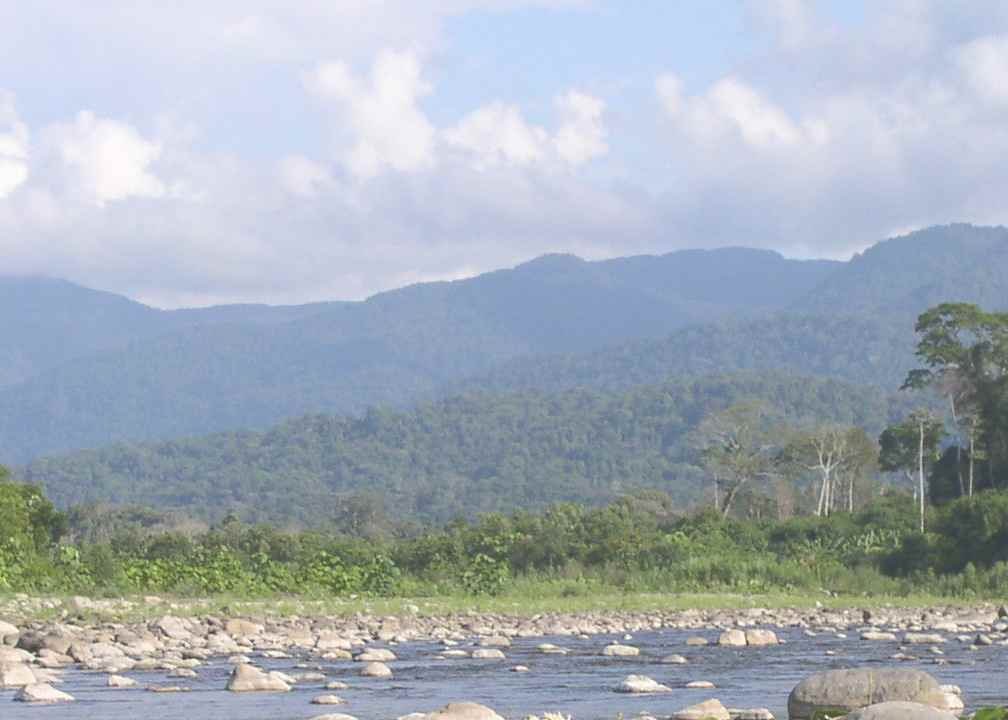 Cabeceras Aid Project
Cabeceras Aid Project Cabeceras Aid Project
Cabeceras Aid ProjectClick here to download this Update as a printable PDF (455KB)
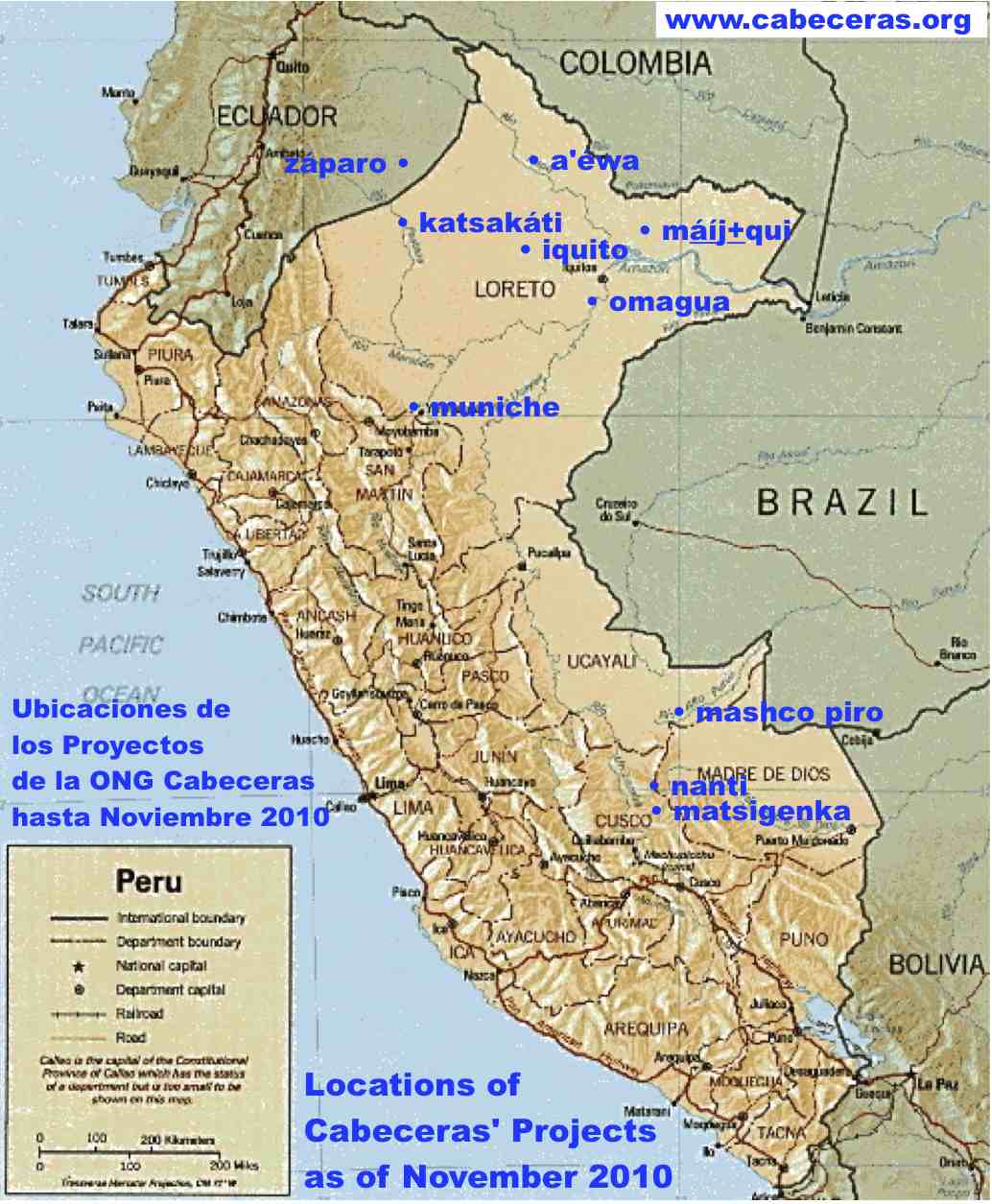 Dear Friends,
Dear Friends,
It is a pleasure to write you and bring you up to date on Cabeceras Aid Project's recent accomplishments and forthcoming activities! 2010 has been an especially full year for our organization, as we have made the most of a number of new opportunities that have come our way. As a result, Cabeceras' volunteer fieldworker Chris Beier spent six months in Peru this year (May to November) carrying out a variety of projects for our organization, and will be departing again on Christmas Day for another eight months of work, this time in Peru and Ecuador. Volunteer fieldworker Lev Michael (now also a professor at the University of California, Berkeley) was able to spend two months working in Peru this year, and will spend seven months in Peru and Ecuador next year — read on for further details.
As you'll see below, most of Chris' and Lev's work in Peru unites Cabeceras' mission of humanitarian community service with separately funded research projects, so that the financial costs actually incurred by Cabeceras in most of these field projects are modest. This year, we're focusing our fundraising appeal to you on just two projects: the Scholarship Program and the Máíj+qui Project. We hope you can make a donation — of any size! — to Cabeceras before 2010 comes to an end; see below for donation information.
Starting with the basics: Revisiting Cabeceras' mission statement
Cabeceras Aid Project is a 501(c)(3) non-profit organization registered in the state of Texas. Our organization's founding mission is:
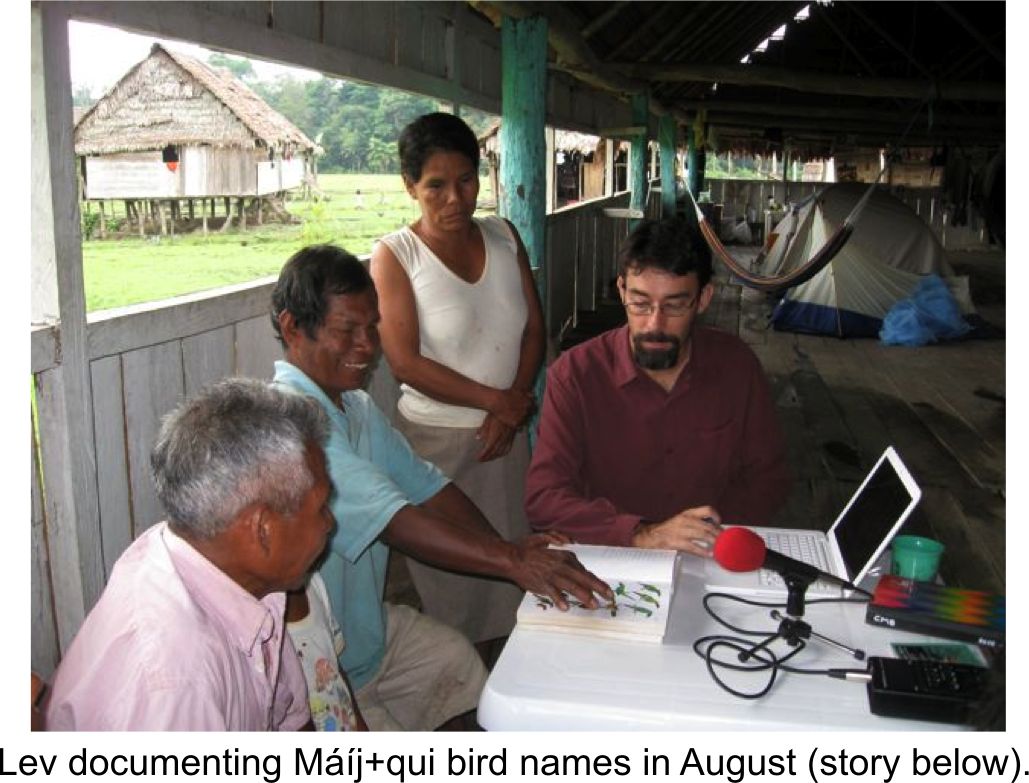 An important announcement: ''I've graduated!''
An important announcement: ''I've graduated!''
(by Christine Beier, one of Cabeceras' founder-fieldworkers, and Secretary and Treasurer). A big event happened in my life in 2010 that I believe will have substantial positive consequences for Cabeceras: I graduated in May from the University of Texas at Austin, with a PhD in Linguistic Anthropology. This is good news for Cabeceras because I am now available to volunteer much more of my time to Cabeceras and its projects. My goal for the next four years is to focus on the related activities of fieldwork, grant-writing, and publication of language and cultural documentation materials, in ways that will further both Cabeceras' mission and my own personal and professional objectives.
Growing our Scholarship Program in 2011
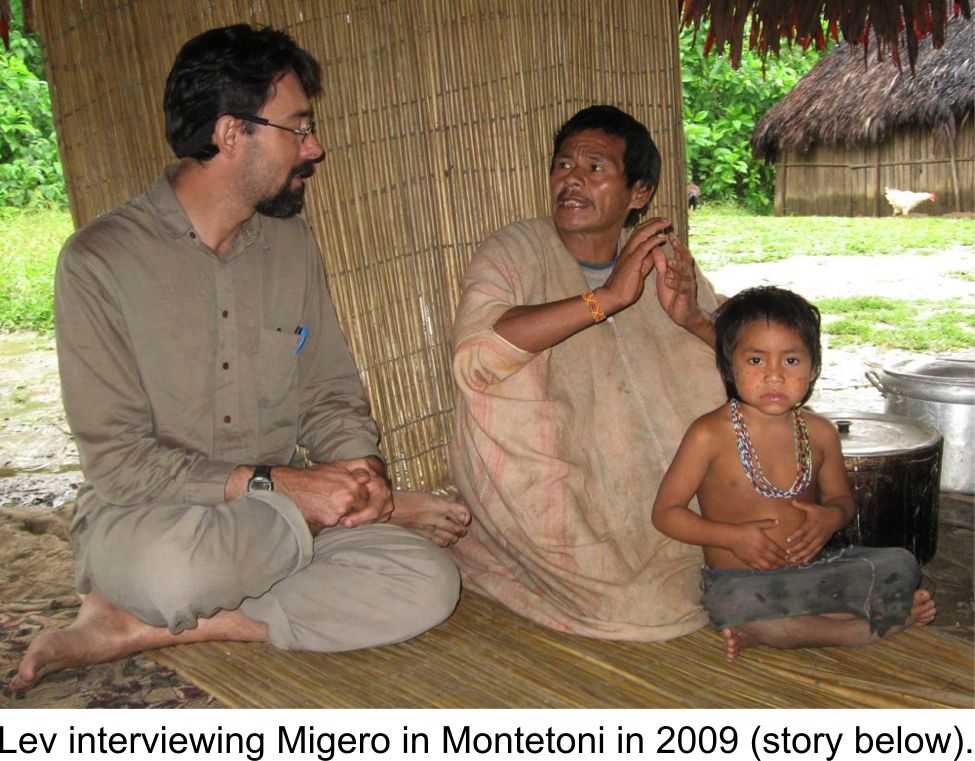 Over the years, Cabeceras has given small scholarships to a few highly motivated indigenous individuals in Peruvian Amazonia for continuing education. These scholarships are a concrete way to cultivate individual talent and potential that can later bear substantial fruit for the indigenous groups and communities we work with. An important development in Cabeceras' commitment to adult education for indigenous individuals was the establishment of the Nathaniel Gerhart Memorial Scholarship Fund in 2007, which has enabled us to provide more substantial support to each awardee than we could before.
Over the years, Cabeceras has given small scholarships to a few highly motivated indigenous individuals in Peruvian Amazonia for continuing education. These scholarships are a concrete way to cultivate individual talent and potential that can later bear substantial fruit for the indigenous groups and communities we work with. An important development in Cabeceras' commitment to adult education for indigenous individuals was the establishment of the Nathaniel Gerhart Memorial Scholarship Fund in 2007, which has enabled us to provide more substantial support to each awardee than we could before.
Because of the positive results we have seen with our two current NGMSF awardees (see below), as well as our success thus far in fundraising for this particular program, Cabeceras will provide scholarships for up to three additional students in 2011. Better yet, we have chosen a special focus for our Scholarship Program in 2011: supporting Matsigenkas to become healthcare professionals. Cabeceras' board is very enthusiastic about this new initiative, because it has the longterm potential to substantially improve the quality of healthcare that Matsigenka communities will receive, once these new Matsigenka healthcare professionals begin to work within the Peruvian healthcare system.
While in Peru in 2010, Cabeceras' fieldworker Chris Beier did substantial legwork seeking out potential applicants for scholarships in 2011. She reports that the initiative was embraced with great enthusiasm by Matsigenka leaders and community members alike, and that some very promising applicants have been found. At this point we anticipate excellent results from this new initiative.
Please consider making a contribution to our Scholarship Fund before the end of 2010!
Cabeceras' website has a new look
In 2010, Chris gave Cabeceras' website, www.cabeceras.org, a much-needed make-over. All pages have a new clean and bright design; navigation is easier; pages have been reorganized for more stream-lined content; and lots of new content has been added throughout, including maps, more photos, and various materials produced over the years by our language documentation and revitalization teams. Check it out!
Cabeceras is on Facebook, too
Several years ago, longtime supporter Kathryn Metz set up a Facebook group for ''Cabeceras Aid Project'' (search for it to join it!). Thanks again, Kathryn! In 2011, Cabeceras will take fuller advantage of this resource as a means to disseminate information about our organization, as well as to attract new supporters, new donors, and perhaps even some new volunteers.
Cabeceras' Field Projects
Omagua Language Documentation Project
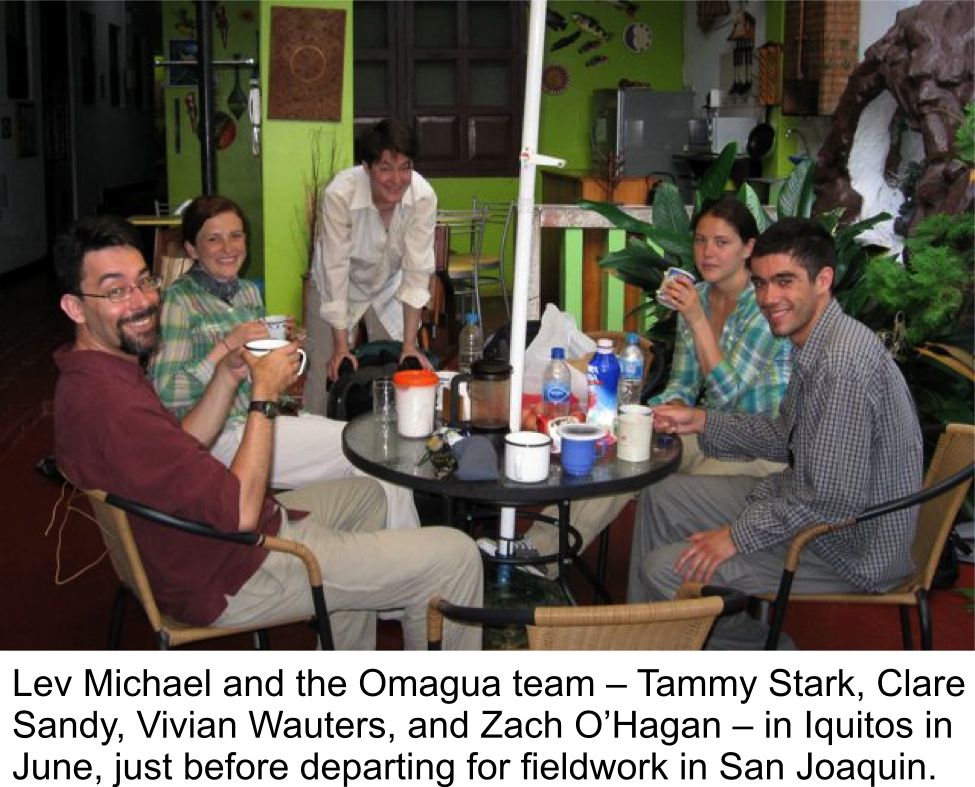 Back in 2003, Cabeceras began to support Arnaldo Huanaquiri in his efforts to document Omagua, a highly endangered language of which Arnaldo is one of the very last speakers. Ever since then, Arnaldo has always wanted to do more documentation work than our fieldworkers could manage! At last, in 2010, Lev Michael obtained a collaborative grant through the National Science Foundation (NSF) for documentation of Omagua between 2010 and 2013. Thanks to that grant, a team of four students (see photo) from UC Berkeley spent two months working with Arnaldo, as well as discovering four more speakers willing to collaborate on language documentation. And again thanks to that grant, for the next few years Cabeceras will only provide logistical support to this project!
Back in 2003, Cabeceras began to support Arnaldo Huanaquiri in his efforts to document Omagua, a highly endangered language of which Arnaldo is one of the very last speakers. Ever since then, Arnaldo has always wanted to do more documentation work than our fieldworkers could manage! At last, in 2010, Lev Michael obtained a collaborative grant through the National Science Foundation (NSF) for documentation of Omagua between 2010 and 2013. Thanks to that grant, a team of four students (see photo) from UC Berkeley spent two months working with Arnaldo, as well as discovering four more speakers willing to collaborate on language documentation. And again thanks to that grant, for the next few years Cabeceras will only provide logistical support to this project!
Muniche Language Documentation Project
In 2008 and 2009, Cabeceras provided logistical and partial financial support (the major part came from a grant from NSF) for a team of fieldworkers to carry out documentation of Muniche, a highly endangered language spoken near Yurimaguas, Peru. At the end of 2009, the team produced and delivered various printed materials for use by the heritage language community. This year, Steph Farmer and Greg Finley, UC Berkeley students who did fieldwork on Muniche in 2009, visited the community to deliver an audio version of the dictionary. People were delighted with it. In 2011, audio materials from this project will become available at: www.cabeceras.org/cap_data_products.htm
A'+wa (Vacacocha) Documentation
In 2008, fieldworker Lev Michael went looking for speakers of a supposedly extinct language known as Vacacocha, on the upper Napo River. He found one rememberer, Delia Andi, and worked with her for a few short days on language documentation. At that time she told Lev two very important things: first, that she called the language A'+wa, not Vacacocha; and second, that another rememberer named María was to be found on the Momón River.
So this May, Lev sought out and visited that María on the Momón. It turned out that she remembered very little A'+wa, but what she did remember confirm data that Lev had gotten from Delia in 2008. Therefore, in September of this year, Chris worked again with Delia, and over the course of ten days, Delia produced and confirmed 160 words and short sentences. Based on those data, Chris and Lev are working on an article on the sound system (phonology) of A'+wa. In 2011, Chris will deliver copies to Delia and her family of all the audio and video materials they produced together.
Máíj+qui Project
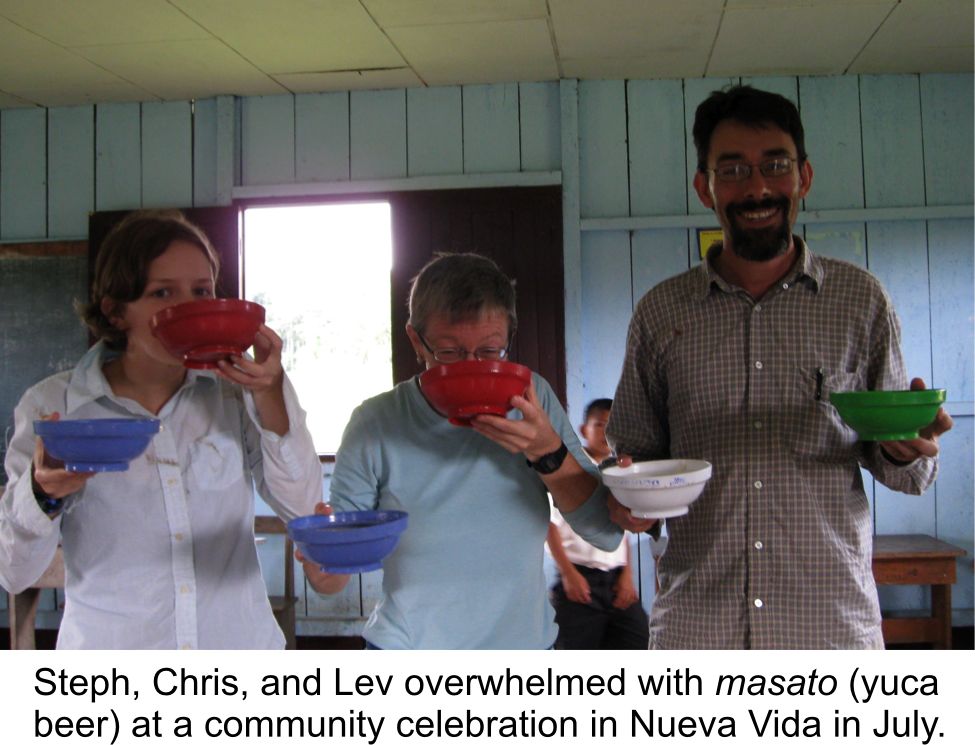 Máíj+qui is an under-documented language spoken by about 100 Máíjuna people, spread out in four communities in northern Peru. In 2005, fieldworkers Lev and Chris made a trip to Máíjuna territory, visiting three of the four communities, and laid the groundwork for future language documentation and revitalization work on Máíj+qui. The Máíjuna people had begun a cultural revitalization effort in 2003, and were very enthusiastic about working with us. Although the number of speakers is small, the possibility for revitalization is very good, since there are fluent speakers in their 30s and even some children who understand Máíj+qui.
Máíj+qui is an under-documented language spoken by about 100 Máíjuna people, spread out in four communities in northern Peru. In 2005, fieldworkers Lev and Chris made a trip to Máíjuna territory, visiting three of the four communities, and laid the groundwork for future language documentation and revitalization work on Máíj+qui. The Máíjuna people had begun a cultural revitalization effort in 2003, and were very enthusiastic about working with us. Although the number of speakers is small, the possibility for revitalization is very good, since there are fluent speakers in their 30s and even some children who understand Máíj+qui.
In 2009, Chris attended the annual Máíjuna Federation Congress and formalized a collaboration among Cabeceras, the federation, and the four communities for language work, in the context of a larger multi-year, interdisciplinary biocultural conservation project spearheaded by Dr. Michael Gilmore at George Mason University.
Finally this year, fieldwork began: Chris and Lev, together with UC Berkeley grad students Stephanie Farmer and Greg Finley, spent two months working in Nueva Vida (the community with the most fluent speakers). This first phase of research went very well: the team delivered to community members a draft dictionary with 1000 entries; and recorded and transcribed a number of short texts. In addition, we participated in the annual Federation Congress and in that context laid out the specifics of a three-year collaboration on language and cultural documentation work. The scale of future work will depend on pending grant applications, but Chris, Lev, and Steph, are all committed to two more months of fieldwork in 2011, at whatever scale we can afford.
Camisea Nanti Project
As you may know, Cabeceras' relationship with the Nanti communities on the upper Camisea River has been fundamental to the founding and growth of our organization. It has been intensely frustrating, therefore, that shifts in government policies and administration in Peru in recent years have made it impossible for us to obtain the legal authorization necessary for our entry into the Federal Reserve inside of which the Nantis live. Last year, we were able to enter the reserve for a few days in the capacity of consultants to a team from the Ministry of Health, but such opportunities are rare.
This year, with no official permission to be had, but having made a promise to the Camisea Nanti communities to provide medical and material aid, in May Chris traveled only as far as Cashiriari (the Matsigenka community closest to the border of the reserve), and sent up the promised aid to the communities with Emilio Ankoro, a trusted old friend who, as a Matsigenka, has legal access to the reserve.
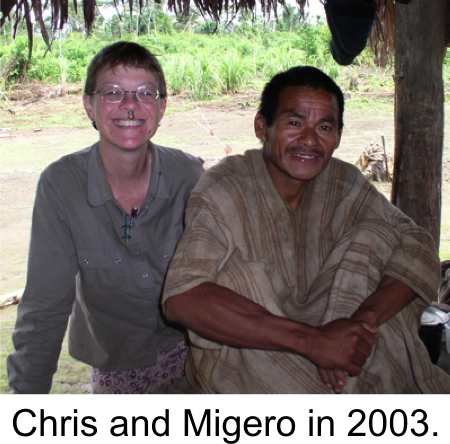 According to both Emilio and Willy Prialé, the Matsigenka schoolteacher stationed in Montetoni, in general the Camisea Nantis have been in good health during the last year. Sadly, though, Migero — the longtime leader of Montetoni and a dear friend to Chris and Lev — died in July, apparently of liver failure. This loss is likely to further destabilize the Nantis' already complicated political situation, and we worry that Nanti self-determination will erode in coming years without Migero as their skillful leader.
According to both Emilio and Willy Prialé, the Matsigenka schoolteacher stationed in Montetoni, in general the Camisea Nantis have been in good health during the last year. Sadly, though, Migero — the longtime leader of Montetoni and a dear friend to Chris and Lev — died in July, apparently of liver failure. This loss is likely to further destabilize the Nantis' already complicated political situation, and we worry that Nanti self-determination will erode in coming years without Migero as their skillful leader.
At this point, we are uncertain how Cabeceras' relationship with the Nanti communities will or can develop in the next few years. Chris and Lev will continue to seek authorization to enter the reserve (to the degree that it doesn't jeopardize their physical or political safety), while knowing that the political tides will inevitably shift again, perhaps next time in our favor.
Urubamba River Valley Medical Aid Project
Cabeceras began the Urubamba River Valley Medical Aid Project in 2002, in order to provide basic medical supplies to communities whose needs for medicines were not being met by the government's healthcare system, primarily due to logistical complexities. Although healthcare in the region has improved somewhat, again this year in May Chris delivered medical aid to eight Matsigenka and Nanti communities in the lower Urubamba River Valley: Nueva Luz, Kirigueti, Camisea, Shivankoreni, Segakiato, Cashiriari, Marankejari, and Montetoni.
Due to the substantial costs of both time (about three weeks) and money that are involved in making these deliveries if a field research period in the region is not also included, Cabeceras' board has decided that our fieldworkers will make deliveries to the Urubamba River Valley in future years only if the journey is also associated with a research trip. Although this was a very difficult decision, the board decided that reducing this aid program at this point is not likely to cause healthcare disasters in the communities we serve; and that the transportation costs are too large a proportion of our annual expenses to justify on their own.
Matsigenka Language Documentation Project
Curiously, although fieldworkers Lev and Chris can hold their own speaking Matsigenka (thanks to 14 years of visiting Matsigenka communities plus its relation to the Nanti language), they have not yet done substantial fieldwork to document this language.
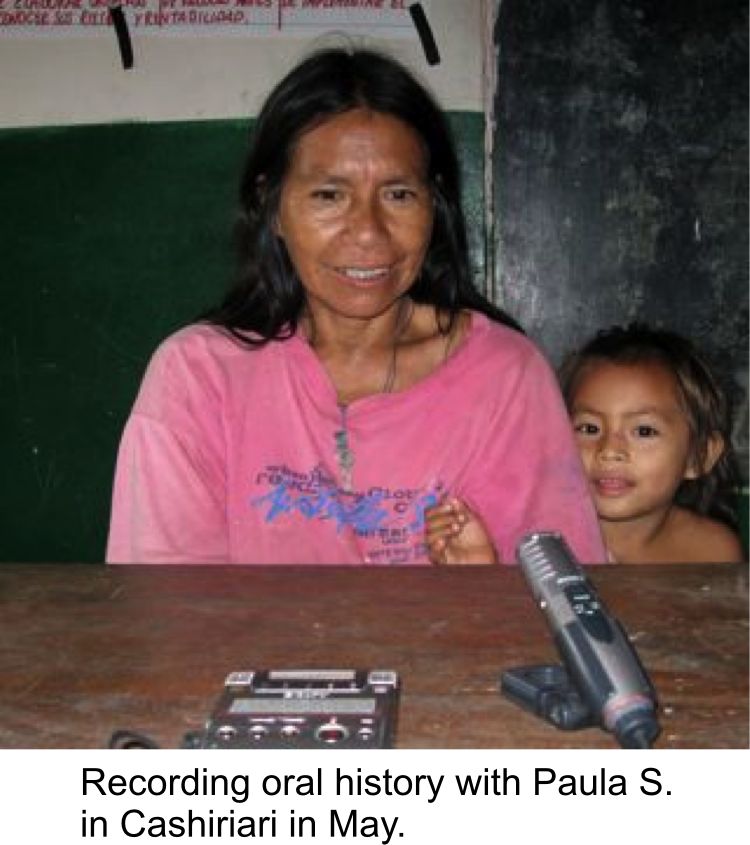 Fortunately, the time to do so has finally arrived, and under excellent conditions to boot: Lev has official leave from teaching at UC Berkeley for the spring semester of 2011 in order to do fieldwork on Matsigenka; and better yet, he won a grant from the Hellman Faculty Fund for this research, through which Chris will also work as a paid consultant. Lev and Chris plan to use the beautiful town of Quillabamba as a base of operations, and travel to various Matsigenka communities in the upper Urubamba River Valley, in order to document both the Matsigenka language and the oral histories of the Matsigenka people. The project will result in numerous community-oriented products, including videos, audio recordings, and text collections aimed at different reading levels, for use by Matsigenkas of all ages.
Fortunately, the time to do so has finally arrived, and under excellent conditions to boot: Lev has official leave from teaching at UC Berkeley for the spring semester of 2011 in order to do fieldwork on Matsigenka; and better yet, he won a grant from the Hellman Faculty Fund for this research, through which Chris will also work as a paid consultant. Lev and Chris plan to use the beautiful town of Quillabamba as a base of operations, and travel to various Matsigenka communities in the upper Urubamba River Valley, in order to document both the Matsigenka language and the oral histories of the Matsigenka people. The project will result in numerous community-oriented products, including videos, audio recordings, and text collections aimed at different reading levels, for use by Matsigenkas of all ages.
In order to lay the groundwork for this upcoming research, Chris spent two weeks in Quillabamba in October and then attended the annual Congress of Comaru, the largest Matsigenka federation. As a result, Lev and Chris are well-positioned for a highly productive field project in the spring.
Iquito Language Documentation Project (ILDP)
Cabeceras launched the ILDP way back in 2001, and for two or more months each year from 2002 to 2006, Lev and Chris coordinated fieldwork teams for language documentation and revitalization work. Since 2007, the labor of the ILDP has shifted primarily to data analysis, writing, and editing, in order to produce a series of digital and print publications in and on Iquito, including an Iquito-Spanish-English dictionary and an extensive multi-media text collection. Gladly, our connections in the community of San Antonio assure us that, as of November, all of our elderly friends (and Iquito speakers) remain in good health. Chris and Lev hope to return to San Antonio in the not too distant future to do some follow-up work.
Záparo Rapid Documentation Project
Ever since beginning work with the Iquito language in 2001, fieldworkers Lev and Chris have had an enduring desire to work with Záparo, one of Iquito's sister languages, spoken in the region of Amazonia straddling the Peru/Ecuador border. So when we were contacted by Brenda Bowser — an ethnoarchaeologist at Cal State U Fullerton who has worked with the Záparo Nation in Ecuador for nearly 20 years — abut a collaborative project on Záparo oral history and language documentation, we couldn't resist! The work is very time sensitive, as the remaining speakers are in their 80s and 90s, and several are in failing health. So Chris, Lev, Brenda, and Vivian Wauters, a linguistics graduate student at UC Berkeley, have put together a project to do rapid documentation work on Záparo in December/January and May/July 2011. Again, the scale of the project will depend on a grant application that is pending with the NSF. Our goal is to provide the Záparo Nation and its members with written, audio, and video materials in and on the Záparo language, which they have specifically requested of Brenda.
Scholarship Program
Current Awardees of the Nathaniel Gerhart Memorial Scholarship Fund
Cabeceras' NGMSF is currently supporting two indigenous Peruvian students, Alex Rodríguez Roque and Percy Paico Pérez, both of whom are studying in the city of Iquitos in northern Peruvian Amazonia. We'd like to tell you a bit about their progress.
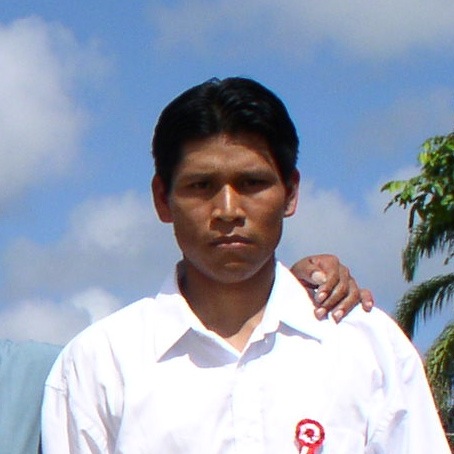 In September of 2008, Cabeceras' Scholarship Fund began supporting its first awardee, Alex Rodríguez Roque (see photo). Alex, now 31, is a native speaker of Bora and Spanish, and is from the Bora community of Pucaurquillo in Loreto, Peru. Already an experienced school teacher and primary school director, Alex had begun studying law in Iquitos at his own expense before he obtained longer-term financial assistance from Cabeceras. A man of exceptional intelligence, integrity, and humility, Alex intends to become a lawyer and work to defend and improve the civil rights of indigenous individuals and communities in Loreto. Now in his eighth of twelve semesters, Alex is making excellent progress toward his degree.
In September of 2008, Cabeceras' Scholarship Fund began supporting its first awardee, Alex Rodríguez Roque (see photo). Alex, now 31, is a native speaker of Bora and Spanish, and is from the Bora community of Pucaurquillo in Loreto, Peru. Already an experienced school teacher and primary school director, Alex had begun studying law in Iquitos at his own expense before he obtained longer-term financial assistance from Cabeceras. A man of exceptional intelligence, integrity, and humility, Alex intends to become a lawyer and work to defend and improve the civil rights of indigenous individuals and communities in Loreto. Now in his eighth of twelve semesters, Alex is making excellent progress toward his degree.
In August of 2009, Cabeceras' Scholarship Fund began supporting its second awardee, Percy Paico Pérez. Percy is an Iquito youth from the community of San Antonio de Pintuyacu in Loreto (whom Cabeceras' fieldworkers first met in 2001 when he was just a little boy). Percy is presently studying in Iquitos to become a Health Technician, and his professional goal is to serve his home community by returning to San Antonio and working in the healthpost there. Percy began his studies in 2008 with the support of his family, and Cabeceras is helping to support him through the second half of his coursework and his practicum.
Cabeceras Aid Project gratefully acknowledges the financial support of the Nathaniel Gerhart Memorial Fund in New York for helping Cabeceras' own small scholarship program grow. Nathaniel's family, and especially Amanda King, at the Memorial Fund have catalyzed a burst of growth and success in our organization that we had previously only been dreaming of. Thank you so much!
Looking forward toward future scholarship awards
As mentioned above, based on the success of our scholarship program thus far, Cabeceras is now growing the program a bit more, and is positioned to support as many as three new awardees in 2011. During 2010, fieldworker Chris Beier has been actively seeking out Matsigenka applicants who are interested in either beginning or continuing their education in a healthcare profession, with the goal that one, two, or even three awardees begin their studies in 2011.
Although the monetary costs of higher education in Peru are in general much lower than they are in the United States, the complex social, economic, and logistic circumstances that indigenous individuals face are daunting and usually prohibitive. Therefore, in addition to providing financial support, Cabeceras commits to mentoring and assisting its scholarship recipients in various ways, in order that they be able to successfully handle all the different kinds of challenges that arise as they continue their formal education.
Please make a donation to Cabeceras this year
As 2010 draws to a close, we ask you to make a contribution to Cabeceras Aid Project to support the unique and valuable work we do. Because we are a 501(c)(3) organization, your donation is tax-deductible. Our Tax ID number is: 74-2799387.
You may send a check to: Cabeceras Aid Project, 1303 Karen Avenue, Austin TX 78757-3017
Or you may donate online using a credit card:
Just click this ''Donate Now'' button to make a secure donation through Network for Good.

Thank you so much for your ongoing support!
Gracias! (Spanish)
Kameti! (Nanti)
Kametitake! (Matsigenka)
Jaari t++! (Iquito)
Deira ja! (Máíj+qui)
Yuse! (Muniche)
 Last updated: 20 December 2010
Last updated: 20 December 2010